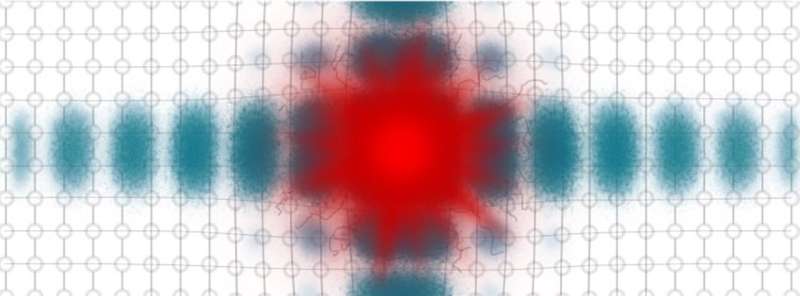This article has been reviewed according to Science X's editorial process and policies. Editors have highlighted the following attributes while ensuring the content's credibility:
fact-checked
peer-reviewed publication
trusted source
proofread
Efficiency boost: Dual light pulses minimize energy for phase transitions

Researchers have explained the mechanisms behind a counterintuitive phenomenon: Making a phase transition effective requires less energy if it is initiated by two pulses of light instead of just one. The energy needed to complete the phase transition has been reduced by 6% and could be further optimized. These results have the potential to be transferred to other materials, offering new avenues for precise material control and technological innovation.
Phase transitions physically transform substances and uniformly change their properties. A typical example is boiling water which transforms liquid into a gas phase, resulting in an abrupt change in volume. There are other phase transitions with high relevance for technologies, such as data storage in compact or Blu-ray disks.
During an optical data storage process, laser pulses change the structural phase of the surface material. The recording marks in disks are created by first melting the material with the laser and then rapidly cooling the molten material below its crystallization temperature; the process changes the reflectivity of the molten areas. This is known as phase-change recording.
In recent years the idea of using not one, but multiple laser pulses to control phase transitions has captured attention ever since it was realized that light could drive transitions coherently. Coherent phase transitions are interesting because they smoothly change the material between two phases.
However, coherent control requires such a smooth connection between the crystal structures of two phases, and excludes many technologically relevant transitions such as crystalline-to-amorphous transitions in chalcogenide glasses for data storage.
A team of researchers led by Dr. Allan Johnson (IMDEA Nanociencia) have demonstrated an alternative, incoherent route for material control that improves the energy efficiency of the phase transition in a material of reference, vanadium oxide (VO2). They found that the phase transition between the metallic and insulating phases when triggered by two pulses, instead of a single pulse, can require less energy.
The material studied—vanadium oxide—is a prototypical system for understanding phase transitions in quantum materials. It lies between charge density wave systems (transformed by a few long-wavelength modes, showing coherence) and crystalline-amorphous phase transitions (local uncorrelated distortions drive the transition, showing disorder). At high temperatures the vanadium oxide is in a metallic phase (rutile), but below 60° is in an insulating phase (monoclinic).

Typically, the excitation of the insulating phase with a pulse of light drives a vanadium dioxide crystal to the metallic phase. Allan Johnson and his team used an alternative strategy. They used a weak pulse to prepare a coherently vibrating state, to further excite the sample with a second light pulse after a small delay (in the range of picoseconds).
To their amazement, they found that the energy threshold, at which the material begins to transform to the metallic phase, depends on the delay between the two pulses and that the energy needed to complete the phase transition is reduced in the double-pulse scheme, in comparison to the single pulse scheme.
The remarkable results indicate that multiple excitations can lower the energy needed to drive the phase transition in vanadium oxide up to 6%. When asked about the improvement, Allan Johnson says, "This may not seem much of an energy saving, but the process still remains be optimized and at the moment we don't know how much we can gain. Furthermore, this method can potentially be applied to many materials, and this is very promising."
The most interesting feature of their discovery is that the process could easily be transferred to existing devices that work with ultrafast pulsed laser beams, simply by dividing the pulse into two and delaying the time between pulses.
Contrary to the limited range of materials that show structural coherence, correlated disorder can, in principle, be induced in any solid. Consequently, the inhomogeneous seeding strategy might be applicable to a broad range of solids, including those used in energy and data storage applications.
The eureka moment for Dr. Johnson was realizing that their X-ray data—acquired non-stop during three long days and nights at X-ray laser facility in Japan—matched the multiple pulse experiments from their own lab. They explained that the mechanism of control involves the formation of polarons, quasiparticles that form due to the coupling of excess electrons or holes with ionic vibrations.
Notably, while other scientists have observed similar phenomena in their laboratory data, the mechanisms behind these observations remained elusive until now. Allan Johnson and his collaborators have elucidated the underlying processes, highlighting the formation of polarons and their ordering in specific directions as a key factor in reducing the energy penalty to the metallic phase. Driving the phase transition by exciting this disordered state of motion can be achieved with less energy.
Furthermore, the dynamic barrier lowering means that scientists are able to selectively reduce the energy required for the laser driven phase transition without increasing the probability of thermal switching, in contrast to other methods for improving the efficiency.
The results have been published in Nature Physics. The implications of this research extend beyond fundamental science, offering new avenues for precise material control and technological innovation. As the team continues to optimize the method and explore new materials, the potential for transformative advancements in material science and optical control remains high.
More information: Allan S. Johnson et al, All-optical seeding of a light-induced phase transition with correlated disorder, Nature Physics (2024). DOI: 10.1038/s41567-024-02474-4
Journal information: Nature Physics
Provided by IMDEA Nanociencia





















